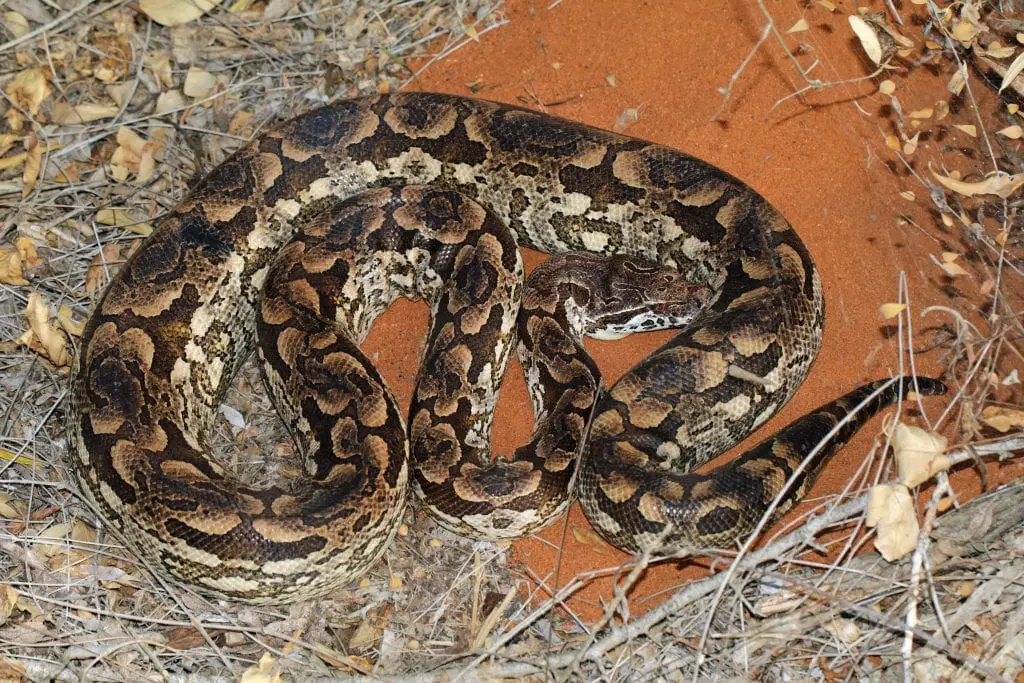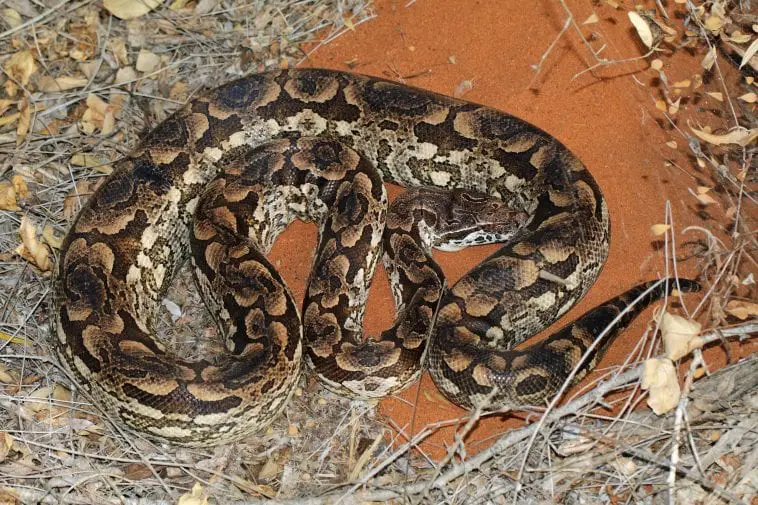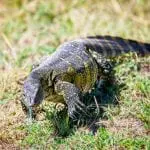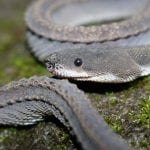Scientific Facts
| Common Name: | Dumeril’s Ground Boa |
| Scientific Name: | Acrantophis dumerili |
| Life Span: | 20 years in captivity |
| Size: | 5 to 8 feet long |
| Habitat: | Forest floor |
| Country of Origin: | Madagascar Island |
Overview

This Dumeril’s boa is called the pearl of Madagascar as it originated from this place. Madagascar is a big island found on the southeastern coast of Africa. This island is home to many reptiles. They stay having a manageable size for their whole life.
They are perfect pets once they get familiar with their homes. Before exporting, these snakes were common. In contrast, to import them from the island is prohibited. It is said that these snakes are facing extinction in their native homes. Fortunately, breeding them is easy.
Physical Description
These snakes are medium-sized. They have a very stock built and has a calm temperament. They come in various colors like red, peach, green, tan, brown, and gray. They have a distinguished marking along their feet, which is called crossbands.
They are the largest, reaching a length of 12 feet from their head to tail. The longest one ever recorded was 18 feet long. They have large and curved teeth which they use to grasp their prey.
The female boas are larger than the males. Boas have many subspecies. The boa from Amazon is the most colorful having a bright cherry red tail. They are great pets, but it is not recommended to be the first pet snake.
Subspecies
Sub Family Boinae
The subspecies are:
- Candoia (Pacific boas)
- Eunectes (Anacondas)
- Epicrates (Rainbow boas
- Acrantophis (Dumeril’s Boa and Madagascar Ground Boa)
- Boa (Boa constrictor, Red-tailed Boa)
- Sanzinia (Madagascar Tree Boa)
- Corallus (Tree boas)
- Candoia (Pacific boas)
Sub Family Erycinae
The subspecies are:
- Lichanura (Rosy boa, sometimes equated with Charina)
- Calabarinae (Calabar Python, sometimes equated with Charina)
- Eryx (Sand boas)
- Charina (Rubber Boas)
- Gongylophis (Rough-tailed Sand Boa)
Size
They range from 12 to 18 inches. They grow slowly, taking 3-5 years to be mature. Females are longer and heavier to support babies they will be having.
The lifespan of Dumerils Ground Boa
These snakes live long when given optimal care. They can exceed 15 years in captivity.
Breeding
The Dumeril’s ground boa is the easiest to breed and keep. Find a good male as a mate to have a good breeding chance. These snakes are sexually mature at 4 to 5 years of age. A female well- fed that is 5-6 long is possible, but wait for another year. Don’t force their sexual maturity. Give good basking area and temperature, plus enough water for drinking and soaking. Feed them with the right size of mice once weak. Don’t make them fat.
Sex them by probing. The male probe would be 10 to 12 sub-caudals. Look for the spurs in the cloaca. Only the males have distinct spurs on the side of their vent. They do a ritual fight, raise their body, and coil each other. Keep pairs in a large terrarium in winter or autumn. Reduce the temperature and reduce the daylight hours from 6 to 8 hours. Reduce food, but always put water. Do this in two months.
After mating, egg bulge appears in the abdomen of the female. Let them bask for the female and her babies to stay healthy. About 6 to 12 babies are delivered after five to seven months. Babies have striking patterns. These babies grow fast in 2 years.
Food and Water
These snakes are opportunistic eaters. They are carnivores. They eat anything in the wild like lizards, birds, and mammals, but in captivity, they eat rodents, frozen prey, rabbit, and more through constriction. When hunting for prey, they wait for a long time before they strike.
Feed them once a week. In the winter, they tend not to eat anything. Some are shy, and you have to cover them in their enclosure or leave them. Always leave a bowl having fresh water. You can use tap or bottled water. These snakes drink lots of water. In addition, they use that water to soak. Change the water daily.
Feeding
Your snake’s prey should be based on its size. Don’t offer preys that are larger than the boa’s widest body part.
Babies that are less than 22 inches long should be given 20 to 30 grams. Juveniles having 2 to 3 inches long would be 30 to 40 grams, others who are 3 to 4 inches long should eat 40 to 70 grams. Sub adults and small adults who are 4 to 6 inches long can eat 70 to 130 grams, and the large adults who are 7 inches long would eat 130 to 250 grams. Give your hatchling and juveniles every 7 to 10 days. Sub adults would be every 14 to 20 days, and adults would eat every 21 to 28 days.
These snakes have slow metabolism; in addition, they get obese so easily. When you see them getting fat, give smaller prey or feed them less. Obesity is a problem among snakes. Don’t be confused with gaining weight and staying healthy. After they eat, don’t feed them within 48 hours.
Before you give a frozen prey, thaw it out in your fried at night before you give it the next day. This is to thaw the food slowly and prevent the growth of bacteria. Then for about 15 to 30 minutes before you feed, put the prey in Ziploc and soak it in warm water. Give them their food using tong. If they are shy, leave them after giving their food. Giving live prey can cause injury to your snake.
Behavior
These species have no venom; however, when they are threatened, they hiss then strike the opponent. Their bite can be really painful. To suffocate their prey, they constrict them. Once it is done, they swallow their prey whole. Digestion of the whole food takes some weeks. They have heat-sensitive pits located on their heads. They use it to sense their environment since they don’t have good vision.
Reproduction
These snakes are ovoviviparous. They don’t lay eggs. Instead, they give birth to their live baby snakes.
In the wild, they mate in spring from March to May when brumation is done. They start mating with males fighting to get females attention. Males’ anal spurs are used to stimulate females when doing courtship. After 6 to 8 months of gestation, the eggs are hatched inside the body of the female; that is why there is live birth of their babies.
The litter has 6 to 10 juveniles or over 20. Their young are 12 to 18 inches long or 30 to 46 centimeters. They are independent as soon as they are born. They grow so fast that they are hunted as food by smaller predators. They reach full sexual maturity at 3-5 years old. Males reach it earlier than females.
Caging and Substrate
You can keep your boas in a 5-10 gallon of glass reptile or just in a shoebox. The young boas could be in a glass, plastic, or wooden cage having 2 ft. long by 2 ft. deep by 14 inches tall. While the adults could be in 4 ft. long by 2 ft. deep by 14 inches tall.
For the substrate, you can use brown butcher paper, aspen shaving, or newspaper. Don’t use cedar and pine shavings because it has oils that can harm your snake’s skin. Newspaper is easy to clean and have.
What Should It Be Made of?
Glass
It is best for dissipating heat. This makes a gradient temperature much easier and induces a natural cycle of drying. This leads to the non-growth of molds when the environment is humid. If you do it right, it will be easy to clean and attractive. Let your snakes feel secure with construction paper the sides except for the front.
PVC or Plastic
This enclosure keeps the humidity well. Plastic cages are more on the floor space than the height, but they tend to be expensive like glass.
Wood
It is light and inexpensive. Treat your wood using a waterproof agent to make it reliable.
Note:
Secure the opening for your snake not to escape. Don’t use tape because it can cause injury as your snake can be in contact with the tape. For glass aquarium, 2 lid clamps can be used. For a front-opening terrarium, use latch or lock. For the tub, use a latching lid.
Don’t house multiple boas together. They are introverts and tend to eat those other snakes.
Lighting
Dumeril’s boa doesn’t need a special type of lighting. Simple lights are enough. UVB is beneficial for your snake’s mental and physical health. Use a fluorescent tube with low-intensity. Put a timer to regular the night and day rhythm. Set it for 13 hours on and 11 off during summer than 11 on and 13 off during the winter.
Temperatures
These snakes have the ability to regulate their own temperature by a heat gradient. Surface temperature is different from air temperature. The surface temperature is higher. This kind of gradient is accomplished in large enclosures.
The basking surface should be 40 to 45 degrees Celsius, warm side air temperature should be 30 to 35 degrees Celsius, and the cool zone is 25 to 30 degrees Celsius. The temperature at night can go down from 21 to 24 degrees Celsius.
Turn off the heat source in the night. Keep the humidity level between 40 and 60. The lower humidity level can cause issues in shedding while higher level leads to issues in the respiratory. Using under tank heat source keep the humidity high. just put a water bowl in the middle of your enclosure, and it will absorb the heat from the enclosure’s hot side.
How to Heat Your Enclosure?
In nature, the warmth is coming from the sun and not coming from the ground. Reptiles burrow to get cooler. Using heat lamps would mimic the sun’s effect as it warms both the ground and air. Use a heat bulb to make the right temperature for basking. Use a bulb that is environmentally friendly. You may buy it from pet stores.
For the belly heat, put a flagstone or a slate tile under your heat lamp for heat absorption making your snake curl up. The deep heat projector is good. Never use heat rocks as it might cause burns to your snake.
Humidity
Humidity level from 50 to 70 works best for you snakes. You can do it by placing a big water bowl in the middle of your enclosure and put a cover on the top. Mist it at night, especially when they shed. If humidity is needed more, add water into your substrate. To mist, use distilled water.
Handling and Temperament
They are very calm. They are shy and don’t want to be handled. If they don’t want to be handled, they will escape. You can do the hook training. This is to recognize when to eat or handle them. Use your hook to nudge your snake’s side. Then hook your snake and pull it towards you. Don’t pull the whole snake to avoid being bitten.
Here is what you can do if you want to shift from a portion of live food to frozen.
- Skip feeding your snake until it is hungry. Don’t handle it.
- Put the prey in a plastic bag and thaw it.
- Remove the water and the prey from the bag. Food the prey in the room to make the room smell like a mouse and entice the snake’s appetite.
- Warm your rodent by using a heat lamp or a hairdryer.
- Pick the rodent using tongs and dangle in the enclosure
- Wiggle your rodent to make it appear alive.
- Wait and have patience.
Handling Tips
- Use a snake hook to take your snake out from its enclosure. This is to train your snake to identify handling and feeding.
- Support your snake’s weight. Snakes are heavy. Support them when handling. Don’t hold it by the head or tail.
- Keep the snake’s head away from your face. These snakes have small teeth, but they can still bite you. Use your hands to guide it away from your face. The level of your hand should be at your eyes’ level.
- Do not let your snake wrap around your neck. Snakes have powerful muscles. Bring one hand up, so it doesn’t wrap you accidentally.
- Keep your eyes open on your snake. Coiling, rapid breathing, and rapid tongue flicking is an indication of a strike.
- Interrupt your snake’s hunt by moving your hands. Give its scale a smooth stroke.
- Don’t surprise them. Use a snake hook when waking them up.
- Do not handle longer than 20 to30 minutes. Begin with three to five minutes. Then, build up.
- Do not handle them for 24 to 48 hours after feeding them. They might vomit what they have eaten.
Conservation / Threats
In the middle of the nineties, this species was classified as vulnerable and reclassified to be least concern species by the IUCN Red list in 2011. In addition, they are listed on CITES Appendix I. It means trading them internationally is prohibited from being used commercially except for scientific purposes.
In China, they are collected for leather trade, but the number is reduced likewise for the international pet trade. Although there is no threat, they are affected by human persecution and deforestation. Fortunately, it is widespread in Madagascar. The Boas population currently is stable and found in protected areas. These snakes are killed as they are seen to bring bad luck and a predator to chickens raised domestically.
Common Health Problems and Treatment
1) Mites
These suck reptile’s blood. Wash hands properly when planning to touch or handle it. Disinfect your hand.
Symptoms are loss of appetite, prolonged soaking, rubbing, lethargy, tiny black dots on the skin, hands, eyes, ears, and vent, ash-like dust on the scales.
The causes are being caught in the wild, poor hygiene, and contamination from reptiles who are infected.
Treatment: Use Nix to kill eggs and mite.
2) Obesity
Symptoms are segmented body, fat rolls, unable to see or feel muscles under their scales, and unable to find their spine. Causes are lack of exercise, fatty prey, overfeeding, lack of exercise, and small enclosure.
Treatment: Give smaller prey. Offer birds. Birds have lean meat.
3) Respiratory Infection
Symptoms are weight loss, lethargy, open mouth breathing, decreased appetite, wheezing sound, and bubbling mucus in the mouth or nostrils. Causes are stress, starvation, poor hygiene, cold temperature, excessive humidity.
Treatment: check the humidity, temperature, and heat gradient. Clean your enclosure. Take your snake to the vet for a prescription.
4) Shedding
Symptoms are defensive behavior, opaque blue eyes, dull scale coloration, lethargy, loss of appetite, and wrinkled skin. Causes are shedding skin, which means growing or gaining weight.
Treatment: prepare a big water bowl for them to soak. Mist the substrate. Don’t handle them or remove the shedding.
5) Rubbing
Symptoms are raw spots on the snout or head. Causes are hunger, too-small enclosure, looking for a mate, mite, and insufficient place for hiding.
Treatment: Flush the wound using diluted iodine with an antibiotic. Give a larger enclosure and enrich the substrate and hides.
6) Weight Loss
Symptoms are reduced appetite, lethargy, and visible spine. Causes are illness, low temps, dehydration, parasites, and not feeding enough.
Treatment: Record the weight. Call your veterinarian if the situation gets worse.
Availability: Where to Get One?
These snakes are readily available. You can buy them from sales on the Internet from reptile breeder or shop or as well as pet stores, expos, and shows.
How to Care
1) Housing
Put the babies in a 10-gallon enclosure. Increase the size after 1-year-old. You can use glass or plastic. For adults, use a 5 feet plastic cage. Put hides and debris. Clean and scoop their waste. Disinfect it or change the bedding. Using a newspaper as a substrate is ideal. They are easy to clean.
2) Lighting and Heat
Give a cool and hot side enclosure. Heat elements should be on a side, likewise with the cool. The basking spot should be at 88 to 90 degrees. The cool side is between 80 to 85 degrees. Don’t give too hot temperatures. Don’t let your snake go near the heat source for them not to get burned.
3) Humidity
Give a non-porous bowl of water. clean the bowl regularly for bacteria not to grow.
4) Feeding
Don’t handle them before and after they are fed. Feed them on a tub or in the enclosure. Use tongs when giving their food. some shy boas should be left alone when eating.
5) Temperament
Always remember to support your snake’s body. Give your pet some time to be familiar with you. Don’t touch the top of their heads. Give them some days to get used to their home. Take care of them properly.
FAQ Section
Where are Dumerils Boas from?
They are from the southern regions of Madagascar. They rarely climb and found on the forest floor. They blend seamlessly on the ground as a cryptic coloration.
Are Dumerils Boas good pets?
They are docile snakes and responds well when eating. Use a hook to feed them.
How big does a Dumeril’s Boa get?
They range from 3-6 feet. The young ones are 12 to 18 inches. They move slowly.
How often should I feed my Dumerils boa?
Feed the hatchlings and juveniles for every 7 to 10 days, the sub-adults for every 14 to 20 days, the adults for every 21 to 28 days.
How many babies do Dumerils Boas have?
Mother boas can lay 6 to 12 live babies having 16 to 19 inches long. They are delivered 5 to 7 months after they mate. They can eat small rodents.
Are Boas livebearers?
Yes, they are. They are ovoviviparous snakes.



